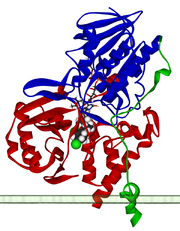
Reversible inhibitor of monoamine oxidase A
Encyclopedia


Drug
A drug, broadly speaking, is any substance that, when absorbed into the body of a living organism, alters normal bodily function. There is no single, precise definition, as there are different meanings in drug control law, government regulations, medicine, and colloquial usage.In pharmacology, a...
s which selectively
Binding selectivity
Binding selectivity refers to the differing affinities with which different ligands bind to a substrate forming a complex. A selectivity coefficient is the equilibrium constant for the reaction of displacement by one ligand of another ligand in a complex with the substrate...
and reversibly inhibit
Enzyme inhibitor
An enzyme inhibitor is a molecule that binds to enzymes and decreases their activity. Since blocking an enzyme's activity can kill a pathogen or correct a metabolic imbalance, many drugs are enzyme inhibitors. They are also used as herbicides and pesticides...
the enzyme
Enzyme
Enzymes are proteins that catalyze chemical reactions. In enzymatic reactions, the molecules at the beginning of the process, called substrates, are converted into different molecules, called products. Almost all chemical reactions in a biological cell need enzymes in order to occur at rates...
monoamine oxidase A
Monoamine Oxidase A
Monoamine oxidase A, also known as MAO-A, is an enzyme that in humans is encoded by the MAO-A gene. Monoamine oxidase A is an isozyme of monoamine oxidase. It preferentially deaminates norepinephrine , epinephrine , serotonin, and dopamine...
(MAO-A). They are used clinically in the treatment
Medication
A pharmaceutical drug, also referred to as medicine, medication or medicament, can be loosely defined as any chemical substance intended for use in the medical diagnosis, cure, treatment, or prevention of disease.- Classification :...
of depression and dysthymia, though they have not gained widespread market share due to limited efficacy relative to other antidepressant
Antidepressant
An antidepressant is a psychiatric medication used to alleviate mood disorders, such as major depression and dysthymia and anxiety disorders such as social anxiety disorder. According to Gelder, Mayou &*Geddes people with a depressive illness will experience a therapeutic effect to their mood;...
s. Because of their reversibility and selectivity, RIMAs are safer than the older monoamine oxidase inhibitor
Monoamine oxidase inhibitor
Monoamine oxidase inhibitors are a class of antidepressant drugs prescribed for the treatment of depression. They are particularly effective in treating atypical depression....
s (MAOIs) like phenelzine
Phenelzine
Phenelzine is a non-selective and irreversible monoamine oxidase inhibitor of the hydrazine class which is used as an antidepressant and anxiolytic...
and tranylcypromine
Tranylcypromine
Tranylcypromine is a drug of the substituted phenethylamine and amphetamine classes which acts as a monoamine oxidase inhibitor —it is a non-selective and irreversible inhibitor of the enzyme monoamine oxidase...
.
RIMAs are displaced from MAO-A in the presence of tyramine
Tyramine
Tyramine is a naturally occurring monoamine compound and trace amine derived from the amino acid tyrosine. Tyramine acts as a catecholamine releasing agent...
, rather than inhibiting its breakdown in the liver as general MAOIs do. Additionally, MAO-B remains free and continues to metabolize tyramine in the stomach, although this is less significant than the liver action. Thus, RIMAs are unlikely to elicit tyramine-mediated hypertensive crisis, and a special diet does not need to be so strictly adhered to, although eating excessively large amounts of tyramine-containing foods is still not advisable.
While safer than general MAOIs, RIMAs still have highly dangerous and sometimes fatal interactions with many common drugs; in particular, they can cause serotonin syndrome
Serotonin syndrome
Serotonin syndrome is a potentially life-threatening adverse drug reaction that may occur following therapeutic drug use, inadvertent interactions between drugs, overdose of particular drugs, or the recreational use of certain drugs...
or hypertensive crisis when combined with almost any antidepressant
Antidepressant
An antidepressant is a psychiatric medication used to alleviate mood disorders, such as major depression and dysthymia and anxiety disorders such as social anxiety disorder. According to Gelder, Mayou &*Geddes people with a depressive illness will experience a therapeutic effect to their mood;...
or stimulant
Stimulant
Stimulants are psychoactive drugs which induce temporary improvements in either mental or physical function or both. Examples of these kinds of effects may include enhanced alertness, wakefulness, and locomotion, among others...
, common migraine medications, certain herbs, or even most cold medicines (including decongestants, antihistamines, and cough syrup).

